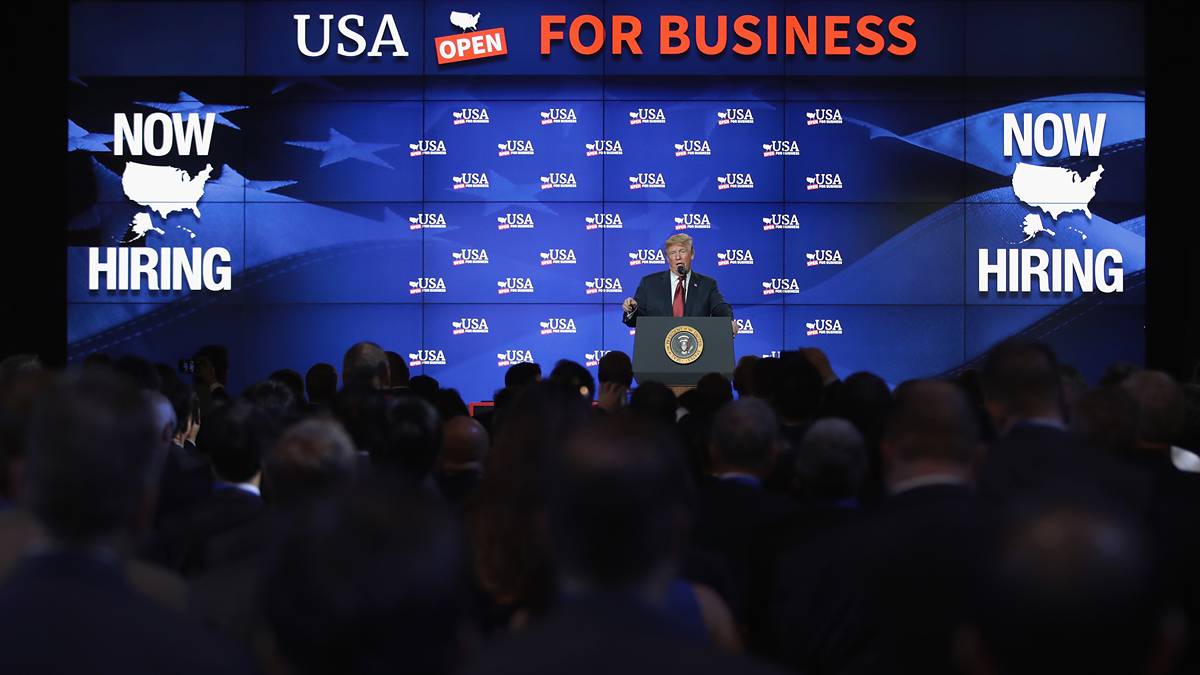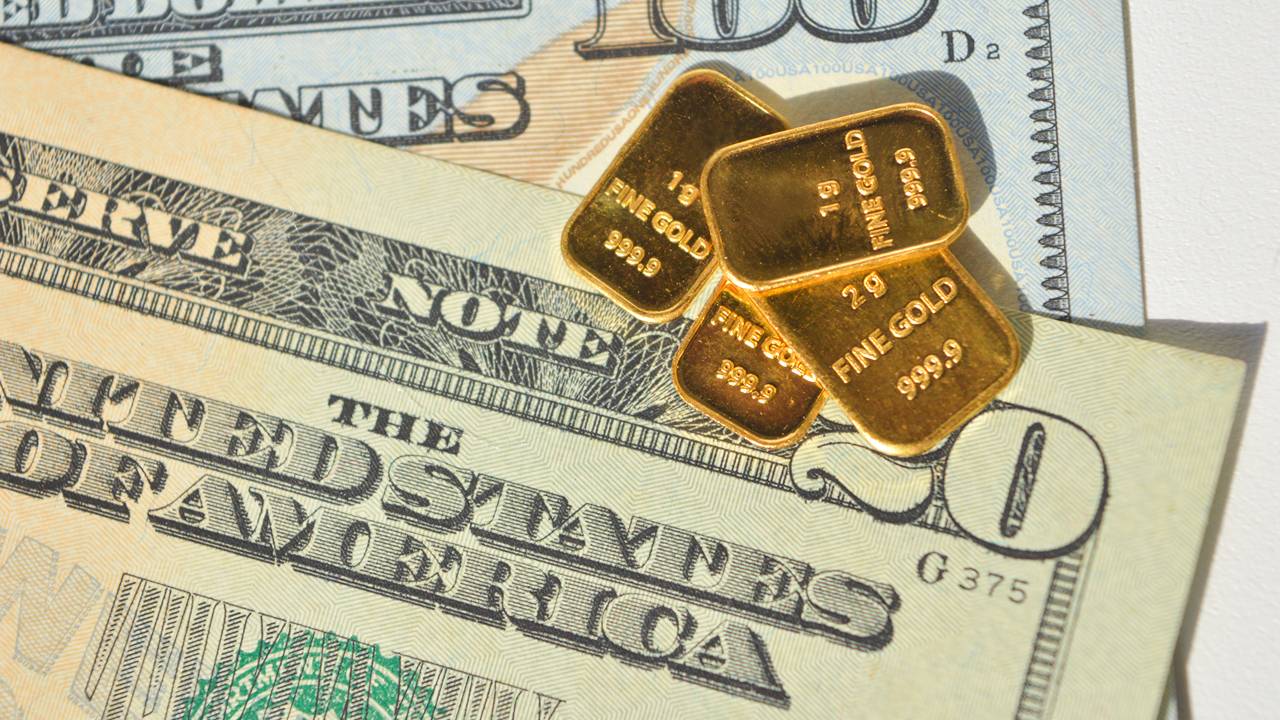Trump Tariffs: Is it time to play the long game on US manufacturing?
Trump’s ‘Liberation Day’ movement has hammered equities, but these ASX stocks are positioning for a US manufacturing boom.

Stockhead
Don't miss out on the headlines from Stockhead. Followed categories will be added to My News.
Trump's tariffs have blown up equity markets, but ASX companies could benefit as the world's biggest economy refires its domestic manufacturing sector
MTM Critical Metals sees big Department of Defense interest in its flash joule heating technology
Fundie Chris Judd says we're in early stages of a long-term theme as the US aims to reshore industrial output
Carnage in equity markets has followed one of the most divisive economic policy decisions in recent times, as a slew of tariffs against America's trading partners shattered market confidence and prompted fears the world's biggest economy could head for a recession.
The close to 17% fall in the tech heavy Nasdaq 100 this year and 13.75% drop in the S&P 500 have pushed the US close to a technical bull market and caused shudders in markets around the world.
But there could be silver linings for ASX stocks focused on domestic manufacturing in the United States, one of the key aims the Trump Administration has pursued in its push to create what the former reality TV star and business mogul has termed a new "Golden Age" for America.
Cerutty Macro Fund's Chris Judd believes we're still in the early stages of the theme, as the US, and even EU governments like Germany, seek to reshore industrial output.
"From our perspective, we don't have a view on if tariffs are good or bad, because it just doesn't matter. Our job is to try and predict what impact they will have on markets," Judd told Stockhead.
"In terms of why is Trump looking to increase manufacturing capacity in the US? It's twofold. So one, he views it as a way to increase economic activity in the US and provide jobs for the working class, particularly in middle America where jobs have been hollowed post-China entering the WTO in 2001.
"So that's an important component from Trump's perspective.
"But the other component is that the West and its allies haven't been able to win the proxy war in Ukraine because they couldn't compete with the industrial output of a combined Russia and China. So it's got economic importance and then national security importance as well."
Defense demand
Companies seeking to build manufacturing bases in the United States are seeing first hand the interest from Federal and State Government agencies to support manufacturing of both equipment and commodities for critical infrastructure.
MTM Critical Metals (ASX:MTM) boss Michael Walshe was in Austin three weeks ago meeting with Department of Defense officials about a planned demonstration plant for its flash joule heating process to be based in Houston.
Developed by researchers at Houston's Rice University, early testwork has shown the unique process, which involves the heating of a feedstock to over 3000 degrees Kelvin to separate valuable metals, can recover metals ranging from gallium, germanium and indium to rare earths and more at a higher recovery rate and with less energy use.
Those commodities are all critical to defence components like semiconductors and jets.
"A key part of that is going very, very upstream and not just getting the downstream finished product like the radar system that they might be purchasing," Walshe said.
"Essentially their logistical arm called the Defence Logistics Agency, the DLA, they've been told that they need to go all the way up as high as possible as they can in the value chain.
"It's not just securing the supply of those end finished products, but they need to be in full control and understanding of where all the sub-components come from, down to the granular level of the metals that go in there.
"We met a guy from the army who's got a big pool of capital to look at specifically rare earth elements extraction from unconventional sources like wastes and coal fly ash."
MTM recently joined @InvestandTradeWA’s Global Growth Accelerator: Critical Tech in Austin, engaging directly with the US Department of Defense & Defense Innovation Unit (DIU).
The momentum in Washington to reshore gallium, germanium & indium is real — with MTM well placed… pic.twitter.com/JKjn5Yv36B
— MTM Critical Metals (@MTMCriticalMet) March 24, 2025
Walshe said the company has been active evaluating funding opportunities through the Department of Energy and Department of Defense, with MTM revealing yesterday the latter had shown interest in its recovery process to procure precious and critical minerals from e-waste.
Testing on printed circuit board feedstock carrying grades of 551g/t gold, 2804g/t silver and 42% copper demonstrated recoveries of over 95% for gold and titanium, with silver, tin and zinc recoveries exceeding 90% in water-soluble metal chlorides using FJH.
As much a 100% of the gold was recovered to the chloride, with silver recoveries of 97% from the e-waste char residue generated as a by-product of a process that turns the plastics from e-waste into syn-gas.
MTM's US subsidiary Flash Metals USA has now executed a letter of intent with Dynamic Lifecycle Innovation Inc. to produce a target volume of 800t of PCB rich e-waste material annually over a five year period starting in Q4 2025.
It comes on top of a MoU with New York based Indium Corporation, which will supply high grade scrap from which MTM plans to extract gallium, germanium and indium, metals critical to semiconductor chips and solar panels which China has issued export controls on.
Walshe said MTM's partner had seen support from the State of New York for a metals recycling facility in Syracuse.
"We think that it's not just these big agencies like the DOD that are going to be now behind us. We think it's going to be even some of the states," Walshe said.
Building US manufacturing bases
Cerutty has investments in two Australian companies with manufacturing bases already in the United States, which have held up well as markets have taken a hiding in the turmoil of the past month.
Shipbuilder Austal (ASX:ASB) is one Aussie mid-cap which already has a shipyard in Mobile, Alabama, where a large expansion program including the construction of the biggest ship lift on the Gulf Coast is planned for completion by 2027.
"Austal, which has had a really good run is a beneficiary of shipbuilding in the US. They've already got a shipyard in Alabama, which they recently raised $200 million for to expand," Judd noted.
"It's a $1.7 billion market cap, so it's a reasonable size company. I think its PE is around 29 times."
"People use EV/EBITDA more for it, which is about nine and a half times. It's got an enormous order book of $14 billion."
Austal's shares are down close to 3% in the past month, but have risen over 41% YTD. It could also benefit from enormous US levies, ranging up to US$1.5m, on port calls for containers ships largely built in China.
AML3D (ASX:AL3), which opened it technology centre in Stow, Ohio, last year to expand its 3D printed additive manufacturing for the US defence, oil and gas and marine sectors, is another company Cerutty watches closely.
The $78m capped firm is a supplier to Austal and US Navy Additive Manufacturing Center of Excellence, and raised $30m in November last year to expand its technology centre.
"I think for the US to achieve their manufacturing ambitions, it's going to be a much more high-tech, highly-automated type of manufacturing processes than what's occured previously," Judd said.
"We think a company like AL3 could be a beneficiary of that. The big thing the market's waiting for with AL3 is a bit more certainly around the Blue Forge Alliance, which has US$950 million worth of funding to spend on manufacturing process in the US linked to the Navy.
"And we believe about $400 million of that, and that's US, is for additive manufacturing, which is the type of technology that AL3 has.
"They've already sold some 3D printed parts for the Virginia class nuclear subs. So their technology we feel is sort of proven. It's now a wait and see if they can actually execute binding contracts."
True to form for a small cap, AL3 shares have been volatile, coming off the boil and more than halving from early November highs of 26c to 11c on March 11. But it has withstood the tariff storm better than most, lifting 21% in the past month.
Lynas (ASX:LYC) is another building a manufacturing base for light and heavy rare earths in Houston with funding from the US Department of Defense, which has the potential to navigate the "killswitch" China can pull on rare earths supply.
"We don't own Lynas so you know you don't get any points for just talking about something," Judd said.
"But that is the obvious move which China really has leverage over the rest of the world, is some of these critical minerals where they just dominate the processing and often the mining of them as well."
Other stocks with American leverage
They're not the only stocks investing in US manufacturing and value-added processing.
Syrah Resources (ASX:SYR) and Element 25 (ASX:E25) have both looked to the red state of Louisiana as a base for their respective battery materials plants, with Tesla supplier Syrah planning to produce anode material using feedstock from its Balama graphite mine in Mozambique and E25 partnering with Stellantis and General Motors to produce battery grade manganese supplied by a mine in the Pilbara.
$250 million capped Titomic (ASX:TTT) announced the US$7.2 million purchase of a 59,000 square foot facility in the defence industrial hub of Huntsville, Alabama, in February, where it will be set up to produce a squite of cold spray materials from the second quarter of 2025.
One of last year's top performing ASX 300 mining and metals stocks, $710m capped IperionX (ASX:IPX) has had a rough start to 2025. But it did announce a definitive feasibility study yesterday on its Titan critical minerals project in Tennessee, which it claims is the largest source in the US of titanium, zircon and rare earth enriched mineral sands. The study's completion is expected in Q2 2026.
The feasibility study is part-funded by an allocation from a recent US Department of Defense award of US$47.1m, which will also be put towards the expansion of IPX's Titanium Manufacturing Campus in Virginia, where the company successfully commissioned its hydrogen assisted metallothermic reduction furnace in December quarter, converting high-oxygen titanium scrap into low-oxygen titanium metal powder.
With its domestic titanium feedstock, Canaccord Genuity's Reg Spencer and William Jones pinpointed IPX as one of the stocks to benefit from tariff implementation.
"Following Trump's recent EO & the Harmonized Tariff Schedule, all unwrought titanium imports are subject to a 15% ad-valorem tariff, except Chinese sponge which faces an additional 25% tariff (i.e., total duty of 40%). The USA is currently wholly reliant on imported sponge feedstock for metal production," they said in a note.
"Relief for titanium metal manufactures may come from the bipartisan Mar'25 bill "Securing America's Titanium Act" which has stalled in the Senate. The bill would see removal of the 15% general tariff, retention of the 25% Chinese tariff, enhanced monitoring of Chinese supply. However, the impacts are already evident with major titanium manufacturer Howmet Aerospace recently declaring force majeure on the back of tariff uncertainty.
"Given the HAMR process will not rely on imported feedstock, we see the introduction of Ti metal/sponge tariffs as a competitive advantage for IPX."
The views, information, or opinions expressed in the interviews in this article are solely those of the interviewees and do not represent the views of Stockhead.
Stockhead does not provide, endorse or otherwise assume responsibility for any financial product advice contained in this article.
At Stockhead, we tell it like it is. While MTM Critical Metals is a Stockhead advertiser, it did not sponsor this article.
Originally published as Trump Tariffs: Is it time to play the long game on US manufacturing?






